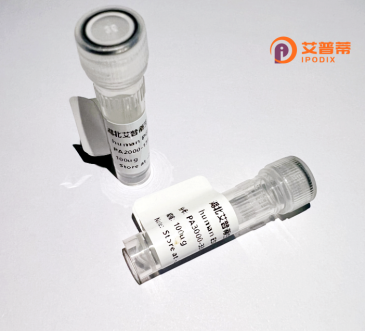
| 纯度 | >90%SDS-PAGE. |
| 种属 | Human |
| 靶点 | TRIM59 |
| Uniprot No | Q8IWR1 |
| 内毒素 | < 0.01EU/μg |
| 表达宿主 | E.coli |
| 表达区间 | 1-403 aa |
| 活性数据 | MHNFEEELTCPICYSIFEDPRVLPCSHTFCRNCLENILQASGNFYIWRPLRIPLKCPNCRSITEIAPTGIESLPVNFALRAIIEKYQQEDHPDIVTCPEHYRQPLNVYCLLDKKLVCGHCLTIGQHHGHPIDDLQSAYLKEKDTPQKLLEQLTDTHWTDLTHLIEKLKEQKSHSEKMIQGDKEAVLQYFKELNDTLEQKKKSFLTALCDVGNLINQEYTPQIERMKEIREQQLELMALTISLQEESPLKFLEKVDDVRQHVQILKQRPLPEVQPVEIYPRVSKILKEEWSRTEIGQIKNVLIPKMKISPKRMSCSWPGKDEKEVEFLKILNIVVVTLISVILMSILFFNQHIITFLSEITLIWFSEASLSVYQSLSNSLHKVKNILCHIFYLLKEFVWKIVSH |
| 分子量 | 73.5 kDa |
| 蛋白标签 | GST-tag at N-terminal |
| 缓冲液 | PBS, pH7.4, containing 0.01% SKL, 1mM DTT, 5% Trehalose and Proclin300. |
| 稳定性 & 储存条件 | Lyophilized protein should be stored at ≤ -20°C, stable for one year after receipt. Reconstituted protein solution can be stored at 2-8°C for 2-7 days. Aliquots of reconstituted samples are stable at ≤ -20°C for 3 months. |
| 复溶 | Always centrifuge tubes before opening.Do not mix by vortex or pipetting. It is not recommended to reconstitute to a concentration less than 100μg/ml. Dissolve the lyophilized protein in distilled water. Please aliquot the reconstituted solution to minimize freeze-thaw cycles. |
以下是关于TRIM59蛋白的3篇参考文献及其摘要内容概括:
---
1. **文献名称**:*TRIM59 promotes tumor growth in hepatocellular carcinoma via activation of the PI3K/AKT signaling pathway*
**作者**:Li Y, et al.
**摘要**:该研究发现TRIM59在肝细胞癌中高表达,并通过激活PI3K/AKT信号通路促进肿瘤细胞增殖和抑制凋亡。机制研究表明,TRIM59通过调控下游靶基因增强肿瘤细胞存活和侵袭能力。
---
2. **文献名称**:*TRIM59 accelerates the ubiquitination and degradation of p53 to drive colorectal cancer progression*
**作者**:Wang C, et al.
**摘要**:研究揭示TRIM59在结直肠癌中通过泛素-蛋白酶体途径介导p53蛋白的降解,从而削弱其抑癌功能。实验证明TRIM59缺失可恢复p53活性并抑制肿瘤生长,表明其作为潜在治疗靶点。
---
3. **文献名称**:*TRIM59 regulates autophagy and apoptosis in gastric cancer by modulating the AMPK/mTOR pathway*
**作者**:Zhang X, et al.
**摘要**:该研究表明,TRIM59通过抑制AMPK磷酸化并激活mTOR信号,抑制胃癌细胞自噬并诱导凋亡抵抗。TRIM59的敲减显著增强化疗药物敏感性,提示其在胃癌治疗中的调控作用。
---
4. **文献名称**:*The role of TRIM59 in immune response and tumor microenvironment remodeling*
**作者**:Liu H, et al.
**摘要**:综述文章总结TRIM59通过调节NF-κB和STAT3通路,促进促炎因子释放并抑制抗肿瘤免疫,重塑肿瘤微环境以支持免疫逃逸,尤其在黑色素瘤和肺癌中表现显著。
---
以上文献涵盖TRIM59在多种癌症中的分子机制,包括信号通路调控、蛋白降解及免疫微环境作用,为其病理功能研究提供参考。
TRIM59 (Tripartite motif-containing protein 59) is a member of the TRIM protein family, characterized by conserved RING, B-box, and coiled-coil domains. These structural motifs enable TRIM59 to function as an E3 ubiquitin ligase, facilitating protein ubiquitination and subsequent degradation via the proteasome. Primarily located in the cytoplasm, TRIM59 interacts with diverse cellular proteins, influencing critical pathways such as apoptosis, immune response, and cell cycle regulation.
Recent studies highlight its dual role in cancer progression. It acts as an oncoprotein in many contexts, promoting tumorigenesis by enhancing cell proliferation, invasion, and metastasis. For instance, TRIM59 stabilizes oncogenic proteins like EGFR and MYC while destabilizing tumor suppressors such as p53. Conversely, its downregulation in certain cancers correlates with poor prognosis, suggesting tissue-specific functions. Beyond oncology, TRIM59 modulates innate immunity by regulating NF-κB and TLR signaling, impacting inflammatory responses and pathogen defense. Dysregulation is also linked to neurodegenerative and autoimmune disorders, though mechanisms remain less explored.
Despite its emerging significance, TRIM59's precise regulatory networks and context-dependent roles require further investigation. Current research focuses on its potential as a therapeutic target or diagnostic biomarker, leveraging its dual influence on oncogenesis and immune modulation.
×